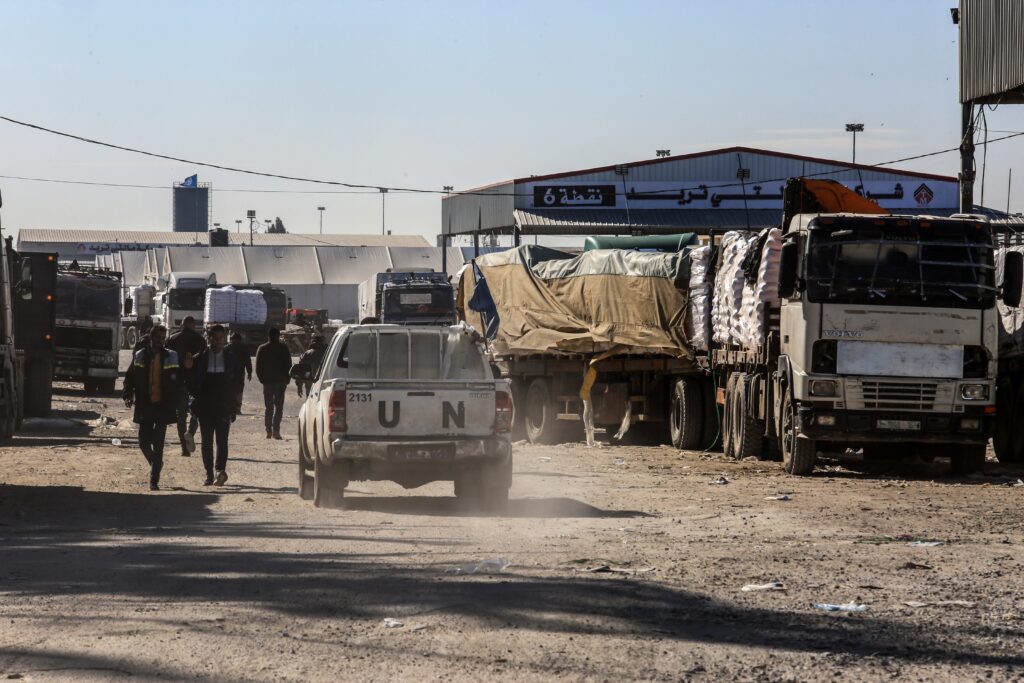Australia/Israel Review
Scribblings: Is enough food entering Gaza?
May 31, 2024 | Tzvi Fleischer

As hopefully everyone knows, Israel says it is allowing all available aid into Gaza and any problems with getting it to Gazans in need is a result of distribution failures. UN and aid agency officials deny this, saying not enough aid is getting in due to Israeli restrictions and delays, and there is “famine” in parts of Gaza as a result. They also often say that, before the war, some 500 truckloads of goods entered Gaza daily (though only a minority of that was food or aid) and to meet Gaza’s needs, a similar number of aid trucks are now needed.
So who’s right – is the problem that Israel does not let enough aid into Gaza or distribution?
A new study done by Hebrew University’s Institute of Biochemistry, Food Science, and Nutrition seems to settle this issue once and for all by simply looking at the relevant numbers. It obtained the registry of each and every truck that entered Gaza through the Rafah and Kerem Shalom crossings from January to April. Reviewing this data, it was found that on average, between January and April, 124 trucks carrying food and humanitarian aid entered Gaza per day, bringing in up to 3,211 calories worth of nutrition per Gazan, per day.
That’s more than the World Health Organisation standard for calorie consumption – which is 2,900 per day for average-sized men and 2,200 per day for average-sized women. Furthermore, the study found that “the quantity and quality of food delivered to Gaza have steadily improved and diversified since January” and “the food supply contains sufficient energy and protein for the population’s needs.”
The study has not yet undergone peer review, but if its numbers are correct, they appear to definitively settle the central question – enough food to feed all Gazans adequately has been crossing the border. The problem thus has to be distribution.
Pier under pressure
Aid distribution problems are highlighted by the fate of the aid brought in through the floating pier built by the US military to import aid to Gaza, which began operating on May 17. Yet five days later, US Defence Department press secretary Major Gen. Patrick Ryder was asked if any of the aid delivered to the pier had reached the people of Gaza. His response was: “I do not believe” it has.
So what happened? According to a report from Reuters (May 20), on May 18, only five out of 16 trucks of aid sent from the pier to a World Food Program warehouse made it – the other 11 were all looted along the way.
The UN, interestingly, did not seem too fussed about this looting, or about securing aid in general. Stéphane Dujarric, spokesperson for the UN Secretary-General, said of this looting: “There was, you know, what I think I would refer to as self-distribution. These trucks were traveling through areas where there’d been no aid. I think people feared that they would never see aid. They grabbed what they could.”
Asked who was responsible for the security of the trucks he admitted: “we don’t have any armed security.” He later added, “the best security, the best safety comes from the community. Right? When people understand and know that there will be a constant flow of aid… We do not operate with armed escort because… there’s certain humanitarian principles, especially operational neutrality, that need to be respected.”
Given this attitude toward looting and security, is it any wonder that the aid coming into Gaza is not being distributed effectively? Or that there are widespread reports that aid packages are for sale in Gaza – such as the New York Times report on May 18, which described street markets in Gaza featuring “Entire aid parcels – still emblazoned with the flags of their donating countries and meant to be distributed for free… stacked on sidewalks and sold for prices few could afford.”
Egypt caused an aid crisis over Rafah
There is no doubt the aid coming in from the US pier is now sorely needed, because the Rafah crossing has been closed by the Egyptians from their side since Israel forces took control over the Gaza side of it from Hamas forces on May 7.
Some media outlets have falsely claimed that Israel is responsible for keeping the crossing closed. Egypt’s Foreign Minister Sameh Shoukry admitted Cairo was the one keeping the crossing closed on May 21 saying, rather disingenuously, that the Israeli military presence and operations put truck drivers in danger, which has led to the cessation of aid crossing the border.
But the situation is actually worse than this because it is not just Rafah which is affected. The nearby Kerem Shalom crossing from Israel to Gaza is open – despite its being rocketed from Hamas-controlled Rafah on May 5, killing four IDF soldiers, and then again on May 8, 10, 11, 12 and 24. But it was receiving little aid because the aid previously arriving at that crossing was largely coming via Egypt, and Cairo was also refusing to let any aid go to Kerem Shalom.
A Biden Administration official affirmed this situation in remarks to the Times of Israel on May 22, saying “What should be going into Kerem Shalom is the UN assistance, which is now in Egypt… Egypt is holding that back until the Rafah crossing situation settles out… Kerem Shalom is open… that aid should be going through Kerem Shalom.”
Israeli Minister Ron Dermer said on May 23, “Right now, Egypt is withholding 2,000 trucks of humanitarian assistance from going into Gaza because they have a political issue about the Rafah crossing.” Egypt began again allowing aid trucks to go into Gaza via Kerem Shalom, but not Rafah, on May 26, following US pressure.






